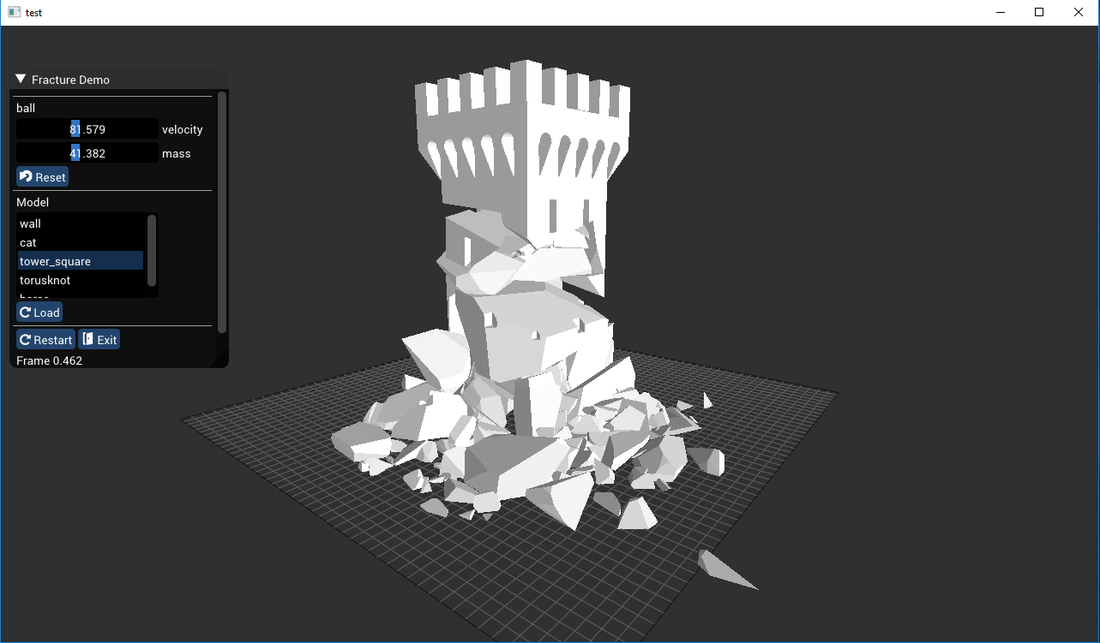I'm trying to implement a constraint that fixes the relative orientation and position of two rigid bodies. My implementation is based on this document http://danielchappuis.ch/download/ConstraintsDerivationRigidBody3D.pdf
The resulting velocity adjustments do not satisfy the constraint and I don't know that I'm doing wrong.
#include <Eigen/Eigen>
using namespace Eigen;
typedef double Real;
typedef Eigen::Matrix<Real, 3, 3> Matrix3r;
typedef Eigen::Matrix<Real, 3, 1> Vector3r;
typedef Eigen::Quaternion<Real> Quaternionr;
typedef Eigen::AlignedBox<Real, 3> AlignedBox3r;
template <typename Scalar>
inline Eigen::Matrix<Scalar, 3, 3> crossProductMatrix(const Eigen::Matrix<Scalar, 3, 1> &v)
{
Eigen::Matrix<Scalar, 3, 3> v_hat;
v_hat << 0, -v(2), v(1),
v(2), 0, -v(0),
-v(1), v(0), 0;
return v_hat;
}
struct RigidBody
{
Matrix3r R; // world-space rotation of the rigid body
Vector3r x; // world-space position of the rigid body
Vector3r v; // linear velocity
Vector3r w; // angular velocity
Matrix3r Iinv; // local-space inertia tensor
Real invmass;
};
Matrix3r compute_inertia_tensor(const AlignedBox3r& box, Real m)
{
const Real a = box.sizes().x();
const Real b = box.sizes().y();
const Real c = box.sizes().z();
return (Real(1.0 / 3.0) * m * Vector3r {
b * b + c * c,
a * a + c * c,
a * a + b * b
}).asDiagonal();
}
void computeMatrixK(
const Vector3r &connector,
const Real invMass,
const Vector3r &x,
const Matrix3r &inertiaInverseW,
Matrix3r &K)
{
const Vector3r r = connector - x;
K.setZero();
K += invMass * Matrix3r::Identity();
K += crossProductMatrix(r) * inertiaInverseW * crossProductMatrix(r).transpose();
}
bool init_RigidBodyFixedConstraint(
const Real invMass0, // inverse mass is zero if body is static
const Vector3r &x0, // center of mass of body 0
const Vector3r &v0, // velocity of body 0
const Matrix3r &inertiaInverseW0, // inverse inertia tensor (world space) of body 0
const Vector3r &omega0, // angular velocity of body 0
const Real invMass1, // inverse mass is zero if body is static
const Vector3r &x1, // center of mass of body 1
const Vector3r &v1, // velocity of body 1
const Matrix3r &inertiaInverseW1, // inverse inertia tensor (world space) of body 1
const Vector3r &omega1, // angular velocity of body 1
const Vector3r &connector, // world-space coordinates of anchor
Eigen::Matrix<Real, 3, 7> &constraintInfo)
{
Matrix3r K1, K2;
computeMatrixK(connector, invMass0, x0, inertiaInverseW0, K1);
computeMatrixK(connector, invMass1, x1, inertiaInverseW1, K2);
const Matrix3r inv_K_trans = (K1 + K2).inverse();
const Matrix3r inv_K_rot = (inertiaInverseW0 + inertiaInverseW1).inverse();
constraintInfo.block<3, 1>(0, 0) = connector;
constraintInfo.block<3, 3>(0, 1) = inv_K_trans;
constraintInfo.block<3, 3>(0, 4) = inv_K_rot;
return true;
}
bool velocitySolve_RigidBodyFixedConstraint(
const Real invMass0, // inverse mass is zero if body is static
const Vector3r &x0, // center of mass of body 0
const Vector3r &v0, // velocity of body 0
const Matrix3r &inertiaInverseW0, // inverse inertia tensor (world space) of body 0
const Vector3r &omega0, // angular velocity of body 0
const Real invMass1, // inverse mass is zero if body is static
const Vector3r &x1, // center of mass of body 1
const Vector3r &v1, // velocity of body 1
const Matrix3r &inertiaInverseW1, // inverse inertia tensor (world space) of body 1
const Vector3r &omega1, // angular velocity of body 1
Eigen::Matrix<Real, 3, 7> &constraintInfo, // precomputed constraint info
Vector3r &corr_v0, Vector3r &corr_omega0,
Vector3r &corr_v1, Vector3r &corr_omega1)
{
const Vector3r connector = constraintInfo.block<3, 1>(0, 0);
const Matrix3r invKt = constraintInfo.block<3, 3>(0, 1);
const Matrix3r invKr = constraintInfo.block<3, 3>(0, 4);
const Vector3r r0 = connector - x0;
const Vector3r r1 = connector - x1;
const Vector3r J_trans_v = (v1 + omega1.cross(r1)) - (v0 + omega0.cross(r0));
const Vector3r J_rot_v = omega1 - omega0;
const Vector3r lambda_trans = -invKt * J_trans_v;
const Vector3r lambda_rot = -invKr * J_rot_v;
corr_v0.setZero();
corr_omega0.setZero();
corr_v1.setZero();
corr_omega1.setZero();
if (invMass0 != 0.0f)
{
corr_v0 -= invMass0 * lambda_trans;
corr_omega0 -= inertiaInverseW0 * r0.cross(lambda_trans);
corr_omega0 -= inertiaInverseW0 * lambda_rot;
}
if (invMass1 != 0.0f)
{
corr_v1 += invMass1 * lambda_trans;
corr_omega1 += inertiaInverseW1 * r1.cross(lambda_trans);
corr_omega1 += inertiaInverseW1 * lambda_rot;
}
return true;
}
Real evalError(
const Vector3r &x0, // center of mass of body 0
const Vector3r &v0, // velocity of body 0
const Vector3r &omega0, // angular velocity of body 0
const Vector3r &x1, // center of mass of body 1
const Vector3r &v1, // velocity of body 1
const Vector3r &omega1, // angular velocity of body 1
const Vector3r &connector)
{
const Vector3r r0 = connector - x0;
const Vector3r r1 = connector - x1;
const Vector3r J_trans_v = v1 + omega1.cross(r1) - v0 - omega0.cross(r0);
const Vector3r J_rot_v = -omega0 + omega1;
return J_trans_v.norm() + J_rot_v.norm();
}
int main(int argc, char ** argv)
{
const Real extents = 2.0f; // each cube is 2x2x2
RigidBody A, B;
A.x = Vector3r{ 0.0f, 1.0f, 0.0f };
B.x = A.x + Vector3r::UnitY() * (1.0f * extents);
const AlignedBox3r box{
Vector3r{ -1.0f, -1.0f, -1.0f },
Vector3r{ +1.0f, +1.0f, +1.0f }
};
const Real massA = 20.0f;
const Real massB = 40.0f;
A.Iinv = compute_inertia_tensor(box, massA).inverse();
B.Iinv = compute_inertia_tensor(box, massB).inverse();
A.invmass = massA == 0.0 ? 0.0 : 1.0 / massA;
B.invmass = massB == 0.0 ? 0.0 : 1.0f / massB;
B.v = Vector3r::UnitX() * +1.0f;
A.v = Vector3r::UnitY() * -1.0f;
//A.w.setZero();
//B.w.setZero();
B.w = { 0.1f, 0.2f, 0.3f };
A.w = { 0.4f, 0.1f, 0.7f };
A.R.setIdentity();
B.R.setIdentity();
// world-space inverse inertia tensors
const Matrix3r inertiaInverseW1 = A.R * A.Iinv * A.R.transpose();
const Matrix3r inertiaInverseW2 = B.R * B.Iinv * B.R.transpose();
const Vector3r connector{ 0.0f, 2.0f, 0.0f };
Eigen::Matrix<Real, 3, 7> constraintInfo;
init_RigidBodyFixedConstraint(
A.invmass, A.x, A.v, inertiaInverseW1, A.w,
B.invmass, B.x, B.v, inertiaInverseW2, B.w,
connector, constraintInfo);
for (int i = 0; i < 1; ++i)
{
Vector3r corr_v0, corr_omega0;
Vector3r corr_v1, corr_omega1;
velocitySolve_RigidBodyFixedConstraint(
A.invmass, A.x, A.v, inertiaInverseW1, A.w,
B.invmass, B.x, B.v, inertiaInverseW2, B.w,
constraintInfo,
corr_v0, corr_omega0,
corr_v1, corr_omega1);
A.v += corr_v0;
A.w += corr_omega0;
B.v += corr_v1;
B.w += corr_omega1;
}
const Real error = evalError(A.x, A.v, A.w, B.x, B.v, B.w, connector);
return 0;
}




